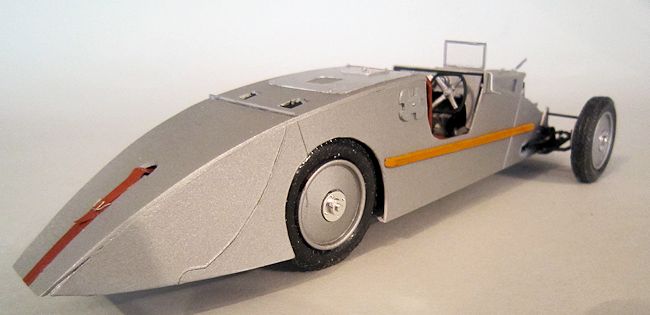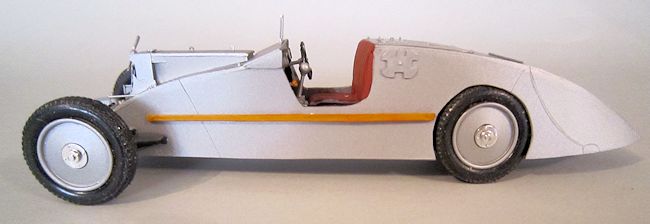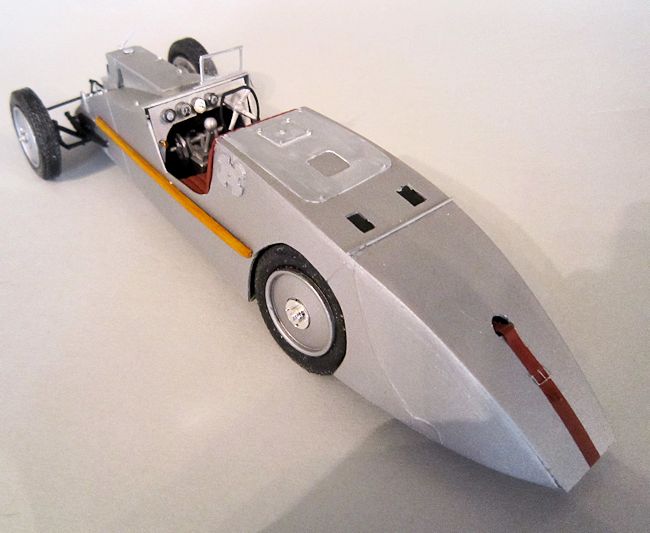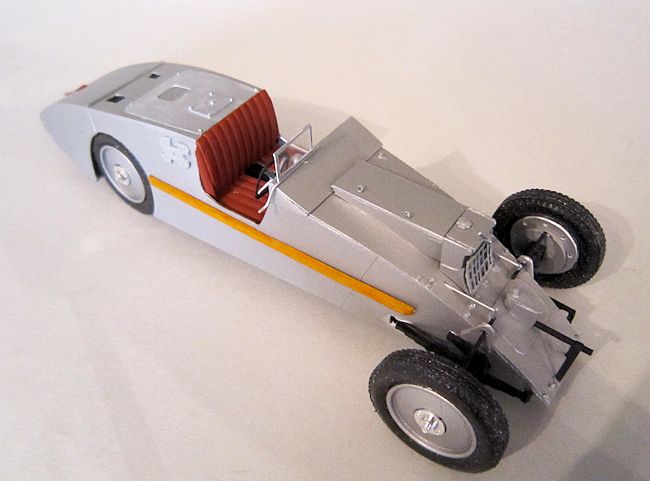
1/25 Voisin Laboratoire 1923
| KIT #: | |
| PRICE: | |
| DECALS: | |
| REVIEWER: | Chris Peachment |
| NOTES: |
A donor kit of the Heller 1/24 Citroen B-14 Torpedo de Luxe, kit number
80732, was used. |

| HISTORY |
After WWI Gabriel Voisin abandoned his pioneering aviation work, citing
the trauma of the military use of his aircraft during the war. From then
until 1958, he concentrated his efforts on making cars. His early production
cars were some of the finest luxury vehicles in the world, with unique technical
details.
 In 1922, by liberal interpretation of the rules, (a French phrase meaning
“cheating”) Voisin won the Grand Prix of Lyon. The organisers were unhappy with
the result and banned the car design for the following year. In response, Voisin
evolved an entirely new concept, the C6.
In 1922, by liberal interpretation of the rules, (a French phrase meaning
“cheating”) Voisin won the Grand Prix of Lyon. The organisers were unhappy with
the result and banned the car design for the following year. In response, Voisin
evolved an entirely new concept, the C6.
It is always difficult to obtain the same horsepower from a sleeve valve engine
compared to one with conventional valves. In addition, Voisin did not have an
engine of the required two litres. He therefore asked André Lefèbvre to design a
light car with good aerodynamics which would compensate for the lower power of
Voisin engines. This is how the Laboratoire was conceived in 1923 and was
the first race car which tried to obtain stability using aerodynamics and also
the first monocoque car.
There is two easy ways to know that Lefebvre was a designer of genius. He went
on to design the Citroen Traction Avant, or Light 15 as it was known in the UK.
It had monocoque construction too, a long wheel base, front wheel drive, and was
the getaway car of choice for some bank robbers who became known as the Traction
Avant gang. It was also used by the villain Le Chifre in Ian Fleming's first
James Bond book, Casino Royale, and Bond finds himself envying Le Chifre's car
as he pursues it in his 1930 Bentley.
Then, as if that were not enough, Lefebvre went on to design the Citroen DS,
another  long wheel base, front wheel drive car of astonishing shark-like beauty.
long wheel base, front wheel drive car of astonishing shark-like beauty.
You can see the genesis of both those models in his 1923 Voisin, which used
light alloy monocoque construction, with aerodynamic body and two rear wheels
set close together, with no differential on the rear axle to save weight. This
would have led to cornering problems, with severe tire scrub, and one wonders
why he didn't go the whole hog, and have one wide rear wheel, with front wheel
drive. The latter feature would have proved problematic on a cart-sprung front
axle however, and would have meant steering difficulties caused by axle tramp
under power. Still, you can see which way he was leaning.
| THE KIT |
The model came about after I bought the Heller Citroen B14 second hand at an air
show at Duxford airfield, near Cambridge. I wasn't aware of the kit until I saw
it, and at £7 it seemed like a snip. Alas, it didn't work out, thanks to my cat,
who despite being a old lady of about 105 cat years, is still a t ough old grannie. She suspected it was an interloper on her turf. The resulting brawl was
1-0 in favour of the cat.
ough old grannie. She suspected it was an interloper on her turf. The resulting brawl was
1-0 in favour of the cat.
It seemed a shame to consign those elegant disc wheels to the Big Bag of Wheels
in the spares box, and so I cast around for something I could scratch build to
use up them and all the other bits and pieces. I did look long and hard at the
Marmon Wasp, the very first winner of the Indianapolis 500, but the wheels on
that were far larger and thinner. Still, that project is on the back burner for
when I can find some suitable wheels for it. I suspect a larger scale Model T
ford might be the answer.
After much internet surfing, I found scale plans of the Voisin Laboratoire, a car I was dimly aware of because the aero-engineering connection with Voisin aircraft. It appealed because the body is basically flat planes, without compound curves, and so can be assembled from plan.
| CONSTRUCTION |
It is the simplest form of scratch building and should present no problems for
someone starting out for the first time. Simply cut the base and body sides from
the plan, glue them together and you already have a sound basis before
continuing. It is best to leave the top panels until after you have done some
detailing in the cockpit. This has to be boxed off, and it is best to introduce
spacers between the sides.
The Citroen's bench seat was hacked about until it fitted, with space for the
transmission tunnel, which also came from the Citroen.
The gear box hump was built up from scrap. There is a curious set of
levers in front of the gear change, which is basically a horizontal rod, with
actuator lobes threaded on it, rather like an
 oversized camshaft. I cannot quite
make out what it does, but must be some sort of gear linkage. Some photos show
it painted in an odd pale metallic green, which I didn't attempt. The gear
change came from the Citroen, as did the steering wheel, cut down and reshaped
to its square form. Instruments of the panel are off cuts from sprue, with some
dial decals on them. One of them is a clock, and I imagine it was a Breguet, for
the mechanic to calculate race times.
oversized camshaft. I cannot quite
make out what it does, but must be some sort of gear linkage. Some photos show
it painted in an odd pale metallic green, which I didn't attempt. The gear
change came from the Citroen, as did the steering wheel, cut down and reshaped
to its square form. Instruments of the panel are off cuts from sprue, with some
dial decals on them. One of them is a clock, and I imagine it was a Breguet, for
the mechanic to calculate race times.
The rear axle was cut down from the Citroen, and embedded on the base.
Then the front axle, and track rod, again from the Citroen, was cut down and
reshaped, and glued in place on its cart springs which had been flattened.
Attention now turned to the front end and this is a lot of fiddly work with rod,
and scraps of plastic to replicate the springs, shock absorbers, starting handle
tube and mount, steering arm, and also the brake rods, which emerge in front of
the radiator and actuate the brakes by means of cunning narrow levers. It is
easier to look at the plans than describe.
The Citroen's radiator was cut down and embedded inside the box-like bonnet
(“hood” to you in the US). And then a grille built up from narrow strip. The
radiator header tank was carved from thick plastic.
 Photos show that the car's panels were covered in large rivets, and the largest
of these were cut from plastic rod.
A test of one's eyesight and steadiness of hand.
I believe that railway modellers use strips of ready made rivets. And even that
there are
3-D
decals for them too
(There are; Archer makes them. Ed).
This would certainly make life easier if you can find some. The two front wheels
need backing plates, from sheet plastic, which were drilled around the
circumference for lightness. The front wheels can be glued onto the brake drums
from the Citroen.
Photos show that the car's panels were covered in large rivets, and the largest
of these were cut from plastic rod.
A test of one's eyesight and steadiness of hand.
I believe that railway modellers use strips of ready made rivets. And even that
there are
3-D
decals for them too
(There are; Archer makes them. Ed).
This would certainly make life easier if you can find some. The two front wheels
need backing plates, from sheet plastic, which were drilled around the
circumference for lightness. The front wheels can be glued onto the brake drums
from the Citroen.
More by luck than judgement the car sat four square on its wheels, without any
embarrassing tire lift. For some reason, the vinyl tires attract dust and
assorted rubbish from all over the place. I suspect that they secretly harbour
static electricity. No amount of scrubbing and scraping makes any difference,
and I half expect to find them covered in tumbleweed one morning. Not that
London has tumbleweed.
Finally, all sorts of fiddly extra panels were added, including those strange
rounded-oblong-with-bites-out-of-the-four-edges things behind the cockpit, which
hide the filler caps for the fuel tank.
| COLORS & MARKINGS |
Mask off the cockpit and blast the whole thing with aluminium paint. The one
dash of chrome I allowed myself were the hub caps, which is probably not
accurate, but I work on the principal that the whole point of a car is to carry
chrome.
| FINAL BITS |
There are two wooden strips alongside the cockpit, which look like vestigial
running boards, but were probably to stiffen the body. A couple of strips of
plastic card were painted mid-brown, and given a coat of
 Tamiya Clear Orange. A
strap for the rear panel, which covers the spare wheel, was fashioned out of
Tamiya masking tape, and a thin wire buckle.
Tamiya Clear Orange. A
strap for the rear panel, which covers the spare wheel, was fashioned out of
Tamiya masking tape, and a thin wire buckle.
The aero-screen was cut from clear plastic sheet, framed by thin strips of card
and glued to its rotating rod mount, with the small handle at the side for the
driver to raise or lower it with his right hand.
Finally, the propeller, a neat little nod to its aeronautic Voisin forbears. It isn't there for show, and in fact drove the oil pump, though presumably not when it was most needed, at start-up, when the car would be stationary. Again I used the fan from the Citroen suitably cut down and sanded.
| CONCLUSIONS |
Formidable. This was the first car I had made for about 40 years, and certainly my first scratch built one. I don't have a large spares box of auto parts, and so was lucky that so much of the Citroen was useable. The beast has a certain je ne sais quoi about it.
There is still one in existence and often has an outing at Goodwood, the famous
race track, outside London. You can find a picture of it on one of the sites
below, with the driver and mechanic sporting Flash Gordon winged helmets, which
seems appropriate to its art deco appearance. The whole thing looks like Le
Corbusier has got at a car.
| REFERENCES |
http://en.wikipedia.org/wiki/André_Lefèbvre
http://www.switchimage.org/Lefebvre_1_E.html
http://www.sportscardigest.com/mullin-automotive-museum-worth-the-trip-from-anywhere/
http://www.linuance.co/m/voisin-c6-laboratoire/
http://www.smcars.netthreads/voisin-c6-laboratoire-1923.23818/
Chris Peachment
May 2014 If you would like your product reviewed fairly and fairly quickly, please
contact
the editor
or see other details in the
Note to
Contributors.